Picture yourself under the sun-dappled shade of an old oak as it whispers in the breeze. There is a celebratory feel to this, our first of gatherings. You are invited to sample the offering of food and drink. Glasses clink. A fire smoulders and you savour a smoky black-bean burger in a freshly baked sourdough bun, perfectly paired with homegrown salads. The sun sets over the mountains and you watch it sink below the horizon. The host introduces a revolutionary woman. For the next twenty minutes you are enraptured by her story.1
October 2015, West Yorkshire, England
I board the Manchester train and five minutes later we’re trundling out of Bradford city while a wiry man with a ticket machine checks our right to travel. I am on my way to Todmorden, to meet James, who is going to teach me something about aquaponics.2
The train slows, not that it ever really seemed to have picked up speed. To get my bearings, I wipe the condensed window with the back of my hand to peek outside. Eureka! The National Children’s Museum in Halifax advertises its presence with brightly-coloured, glossy signage that pops from a sandstone wall. The frontage provides a brief window into the multi-coloured fluorescence of the museum’s offerings. Two children jump up and down on their seat in excitement, they’ve reached their destination.
Next stop, Sowerby Bridge. The original Victorian era building has been carefully restored and preserved. Reminiscent of the Railway Children, I’m transported back in time. A dedication to the brother of the Brontë sisters adorns the wall with an oval blue plaque. Branwell was employed as “Assistant Clerk-in-Charge” at the station from October, 1840 for five months.
The line runs alongside the River Calder and a canal. As we continue, urban sprawl gives way to rural villages. We pull up in Mytholmroyd, a village where I’d once looked for a home, only to discover the prices were out of reach. Instead, I settled for a (cheap) former mill-worker’s terraced house closer to the city. It had a room with a view. Just ten miles from Haworth, birthplace of the Brontë sisters, wind and wuthering is what I lived with for fifteen years.
Before the next stop, I catch a glimpse of commercial narrowboats, each named after an English town. Rain bounces off the water. A chirpy announcer comes to life.
“This train is the TransPennine Express service to …” There’s a brief pause, like an automated answering machine on a phone. “… Manchester Victoria. We are now approaching Hebden Bridge.” Express service? Fifteen miles in forty-five minutes, or thereabouts. I don’t mind. I’ve recently discovered the pleasure of slow living.
Several travellers get up from their seats and make their way to the exit. The autumnal wind chills the carriage each time the doors swish open. Local transport hasn’t changed in all the years I’ve lived here. Heated carriage in summer and no shortage of air conditioning in winter.
Next stop, Todmorden. I rescue my sodden umbrella from beneath my feet and pick up my bag. I make my way toward the exit before I really need to. I still get travel anxiety even when I’ve checked the journey details a thousand times.
Although not as quaint as Sowerby Bridge station, what marks Todmorden differently is a brightly-coloured mural depicting the town’s church and hall, with a foreground of bright green abstract trees.
“Welcome to our Incredible Town.”
Lining the platforms are cone-shaped planters. This isn’t particularly unusual for the Victorian stations of Yorkshire, but what is unique is their contents.
2008, Todmorden, West Yorkshire
In 2008, things looked grim. In Todmorden, even the old stone mill workers houses, blackened by decades of industrialisation oozed desperation. Three new roadways had split the town, fragmenting a formerly close knit community. The largest economic recession since the Great Depression hit hard and young people were leaving school with few prospects.
Pam and Mary, recently retired, sat with their friends around a kitchen table and began to talk, not about their town’s troubles, but solutions.
“We tried to answer this simple question: Can you find a unifying language that cuts across age and income and culture that will help people themselves find a new way of living, see spaces around them differently, think about the resources they used differently, and interact differently?” (Pam Warhurst, TED Talks, 2011)
Not such a simple question when you think about it.
For present purposes, let’s argue the unifying language we currently speak is money. What could replace money to achieve the changes they envisioned? Commit to something in your mind. If you’re feeling brave, pop your response in the comments below.
Meanwhile, here’s a grim picture of a town in decline:
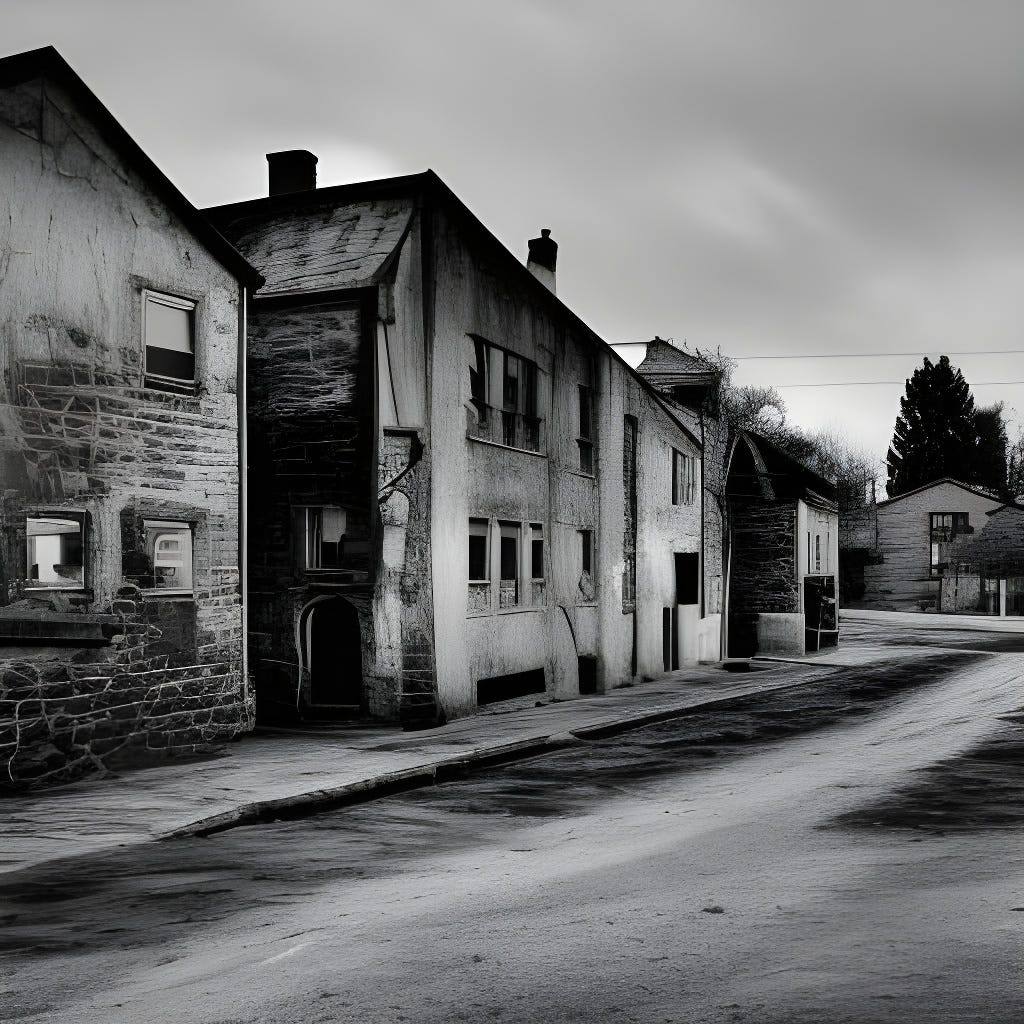
Their answer was food. They were so excited about it, they held a public meeting. The response was overwhelmingly heart-felt. Incredible Edible was born.
2015, Aqua Garden, Todmorden
I take shelter in a waiting area and dive into my small khaki green bag and dig out a map I’d printed from the internet. “The Green Route.” It’s a stylised map of Todmorden, guiding the visitor through the town. On route you pass different Incredible Edible waypoints. These take the form of planters, beds, and orchards, full of edible food and herbs, in addition to bug hotels and a butterfly garden.
Without anyone asking for money, without anyone asking for permission, without anyone filling in irritating bureaucratic forms, Pam and Mary started a revolution. They took over public spaces and planted food. They didn’t have any idea how to grow anything green. It didn’t stop them. They learned as they went along. Now these public spaces are planted, maintained and harvested by a large team of local volunteers.
I’m meeting James at the aqua garden in an hour, so identify two locations I’m most interested in seeing.3
I pass under the railway viaduct, another icon of Todmorden’s Victorian past. The construction is credited to George Stephenson in 1840. Outside the police station, I stop. I don’t see any of the famed photogenic cops, but I do poke around in the photogenic crops. I move on, but not before a few leafy greens are tucked into my sack for dinner. Why does that feel like theft?
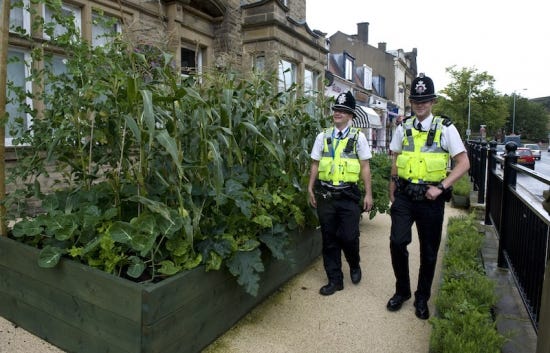
At the entrance to the health centre I am reminded of the saying: “An apple a day keeps the doctor away.” In its thriving orchard, signage invites you to help yourself. I do. Who could resist a delicious rosy cox apple? I put another in my pocket for the journey home. Strangely, I feel guilty about doing so.
The rain conveniently pauses. I linger in the apothecary garden and especially appreciate the Witches’ Bed. Unsurprisingly, these displays are dedicated to the healing properties of plants. The signs are also designed to encourage activities like weeding (or not), and are sufficiently informative to not accidentally eat something that would have you rushing for the doctor in the health centre.
One of the most amazing features of Incredible Edible Todmorden is the lack of funding to realise the project. Whilst occasional grants and gifts have been received, it’s very much a community endeavour. Children, as well as older people, regularly turn up for the volunteer sessions. They pick up litter, pull up a few weeds, plant, water and harvest food. Local artists and designers contribute to signage and explanatory leaflets, and local farmers supply local shops.
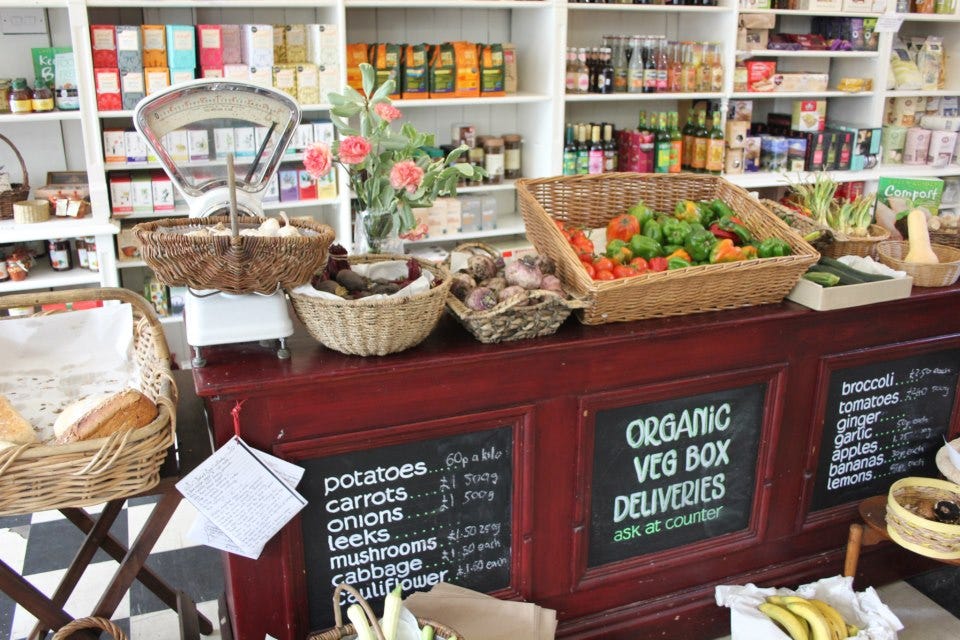
Todmorden is pretty and vibrant, so different to the run down feel it used to have. I’m excited about my visit to the aqua garden. I ask a passing sixth former for directions and he offers to show the way. He dawdles alongside me, hands in pockets halfway down his thighs. “It’s right good,” he says. He then jokes about a volunteer who quit because the fish she cared for was given to a local restaurant.
“From tank to table?” I ask.
He laughs. “That’s a good one. Farm to plate, tank to table.”
“Do you volunteer?”
He shrugs in that way cool students do when you might get the inkling of an idea they might be nerdy. “There’s nothing else for us to do. Not even weekend slave labour.” I tell him most of my students work at Ikea. “Too far, costs more to get there than you earn.” He has a point. We cross the road and he points out a bug hotel. As we get closer to the school, we see chickens crossing the road.
“Me and my friends want to start an eggonomy.”
“Eggonomy?”
“It’s cheaper to keep a flock of free range chickens than to keep them cooped up. You lose some to foxes, but you save on what it costs to feed them. The eggs are better and you get more for them.”
“That’s a good one,” I say. He looks at me like I’m going potty. “Egg economy? Eggonomy!”
He’s still working out the maths of his venture.
“What about land?” I ask.
He looks sheepish, then grins. “We’ll take some. You know, some place there’s prickly plants.”
The homage to Pam makes me smile. An image of chickens running wild on railway banks, followed by an unlikely group of teenage eggtrapreneurs, flashes through my mind.
Once in sight of the aqua garden we part and I wish him luck.
The aqua garden is constructed a bit like a giant polytunnel housing enormous fish tanks containing tilapia and goldfish. During the tour, James talks about the local food economy. Farmers who were initially sceptical about the Incredible Edible initiative are changing their minds, thinking local as much as global. The Incredible Edible team use a single product: eggs, to track how much is bought locally. Buying local is progressively increasing.
The aqua garden uses a closed loop aquaponic system. Waste water from fish tanks feeds nutrients to planters in which a variety of salads grow. Clean, filtered water returns to the tanks. It’s a sustainable, but not a regenerative system. James prefers the work he does outside of the aqua garden. He’s created vegetable and herb beds using companion planting. He pulls back some of the soil he’s nurtured since working at the centre. It’s full of long white fibrous stringy worm-like entities. But they aren’t worms - it’s a flourishing mycelial network. He’s incredibly proud.
While I feel guilty about picking food that isn’t mine, James is keen to ensure my bag is filled with vegetables to share at home. He gets me to compare the taste of the lettuces growing in his rich soil to that grown using aquaponics. I’m firmly in favour of the outdoors. Over lunch, supplemented with the aqua garden’s leafy greens, I tell him about my conversation with the sixth former. James laughs. The fish incident upset a few people, he says. He defends the system, that’s the point, isn’t it, to create two sources of food: fish and plants? Why grow food if someone doesn’t eat it?
In fact, one of the initial barriers to the success of Incredible Edible is that people feel awkward about harvesting. Such is the strength of social conditioning, we have to be encouraged to pick the food. Although available in public spaces, these are still seen as somebody else’s, not ours. Incredible Edible doesn’t just grow free food, it’s fostering a transformational narrative.
2023, Coimbra region, Portugal
Five years after my Todmorden visit, an old, rickety bookcase becomes the foundation for the first raised bed in my garden. I begin the process of soil building using only the organic matter immediately available. It starts with mouldy leaves.
Earlier this year, during a mutual work exchange with a friend, she asked if I wanted the bed dug over.
I squatted to pull back a handful of the soil, just as James had done with me. Stringy, white fungal threads spread through a soil which had turned from the colour of yellow clay to a deep dark brown. I was super proud!
I wonder what James is doing now?
And I wonder if there are any chickens running wild beside the railway track?
I guess I’ll never know.
But I do know how to grow my own food.
Up next:
With this newsletter, I don’t just want to tell stories. Though inspiring, a little more is needed if they are to engage action. After each, I hope you’ll join in a discussion where we consider what we can take away from the story for our own lives and neighbourhoods.
How successful was Incredible Edible?
How much of a revolution did Pam and friends really start?
How replicable is the original model?
Could it work in your locale?
In the next post, I will address the answer to these questions and examine some of the ‘science’ behind the success of Incredible Edible. These might be questions you’d like to consider ahead of time. If you do, I’d love to hear your initial thoughts.
Over to you!
Celebrating the launch of The Fiertzeside
If you love reading inspiring stories about quiet revolutionaries like Pam and Mary, please hit the subscribe button below. You will receive one newsletter per week. Free subscribers will be able to read each post for four weeks after publication whereas paid subscribers have full, permanent access to the archive. Why not take advantage of this opening offer? Your generosity will help support a project, which I’ll tell you all about in my thank you letter.
40% off all payed subscriptions for life!
Offer open until September 30th, 2023.
Embers
The dying embers of the newsletter will include a roundup of what I’ve been reading that I think you might enjoy. If you like positive stories and the search for wonder, awe, and beauty in your life, this is for you.
This week, I discovered
. In it, delves into “how enchanting states create united states”, and yes, without the capital letters! It’s an intriguing concept which, for me, sparked a lot of post-read creativity. Tara’s depth of enquiry is detailed and thought-provoking. The publication has evolved from its original direction, and to map its wider territoryhelpfully created a mudroom (much like Incredible Edible’s ‘Green Route’) so newcomers can easily find their way around. Click below to make your way there.The Fiertzeside has real-world existence. It is located in Portugal just outside a small village with a population of about 70. We share food under an old oak and when available, the ingredients are fresh from our one acre garden.
James is not his real name.
The aqua garden was one of the few aspects of Incredible Edible Todmorden dependent on external funding. A lottery funded project, it lasted five years before closing in 2018.





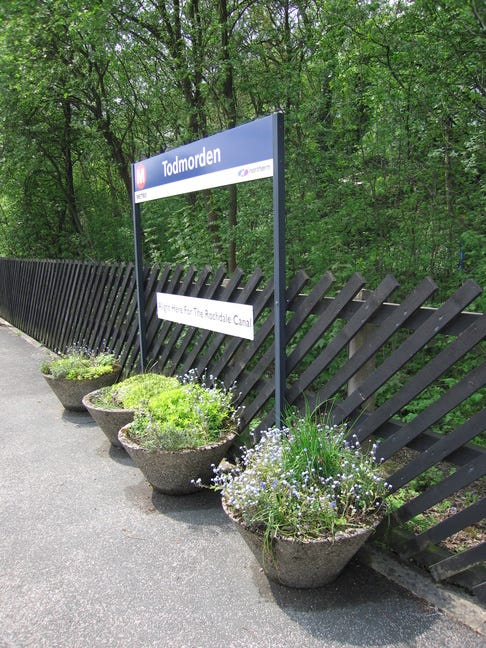
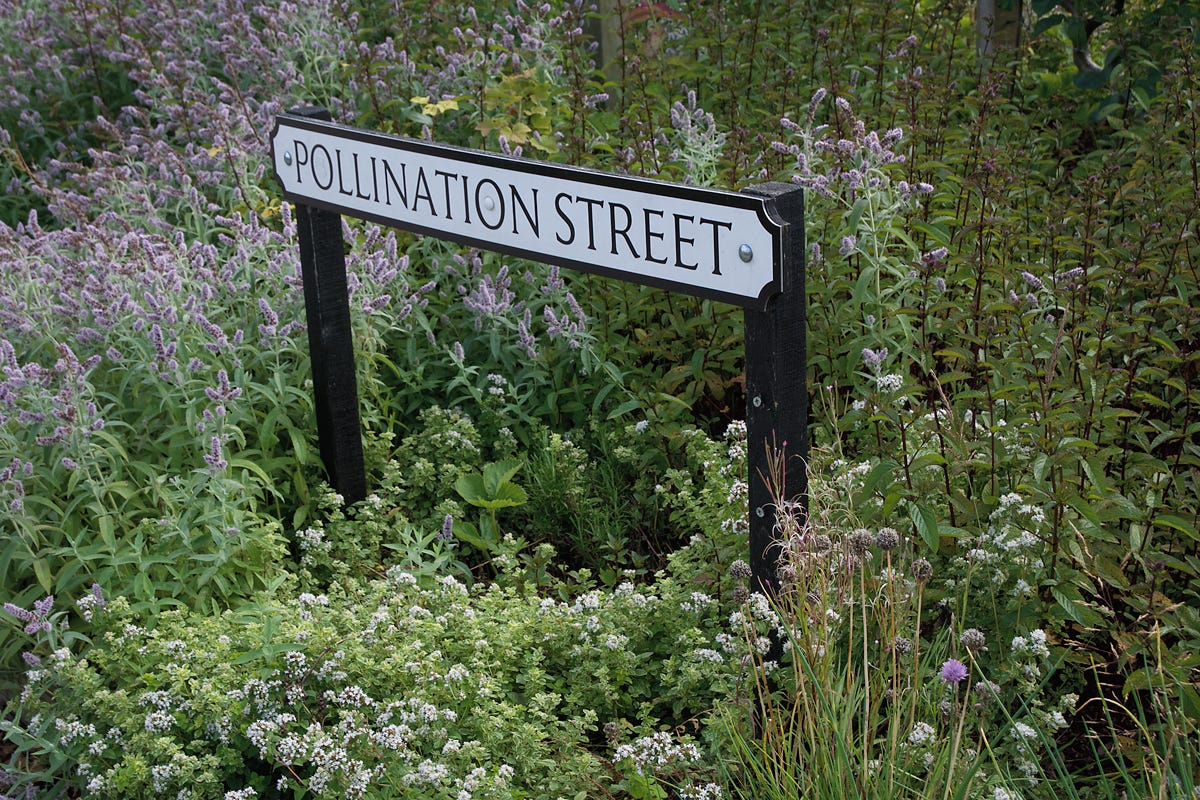
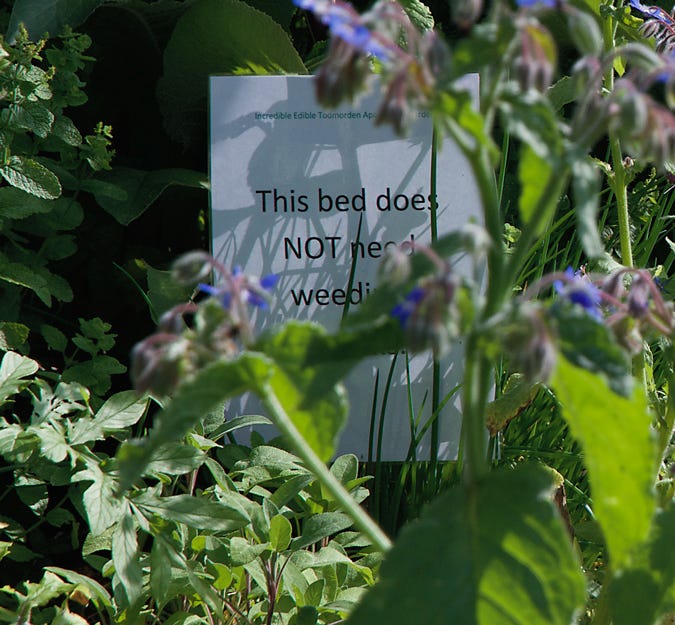
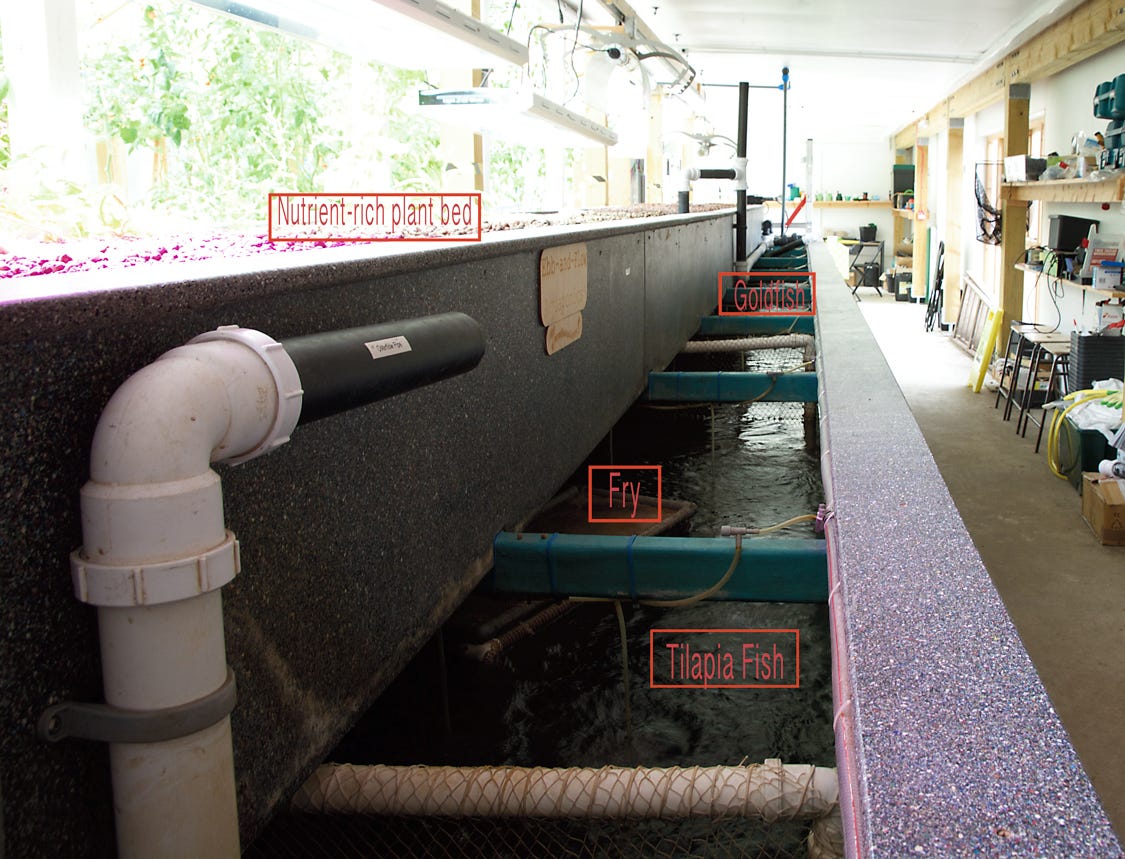
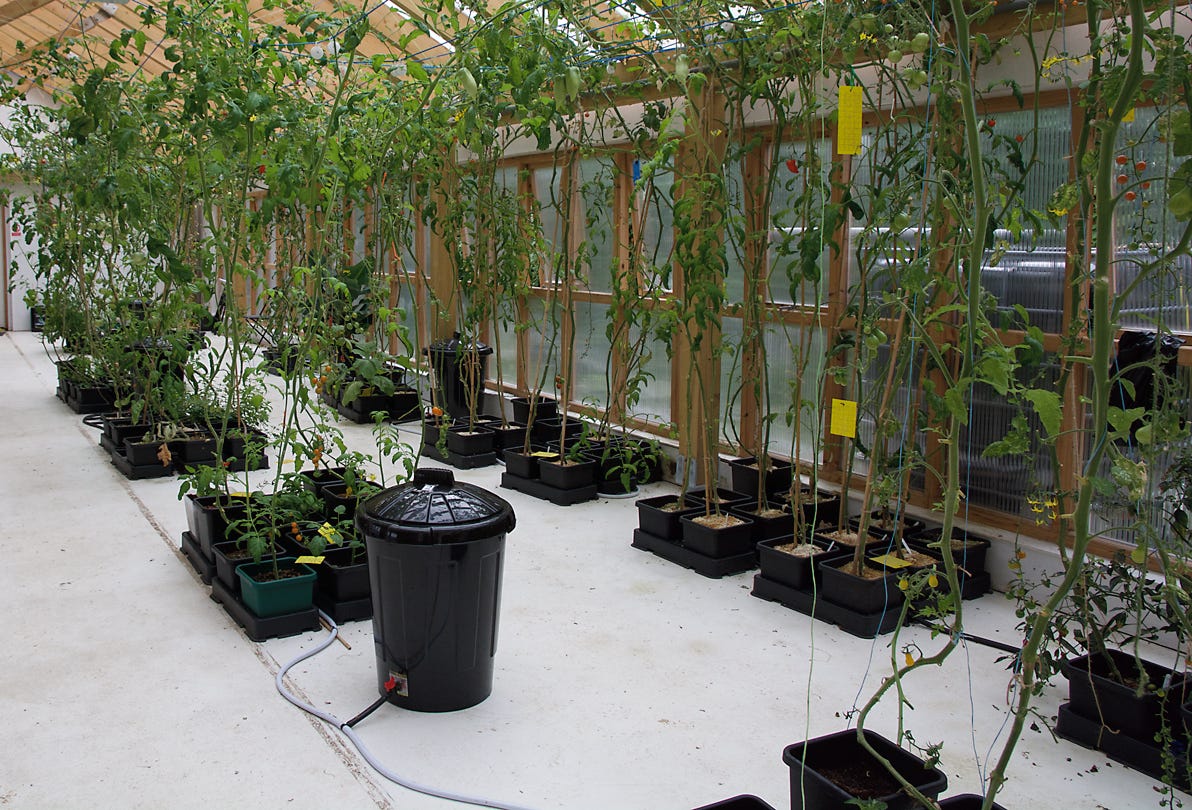
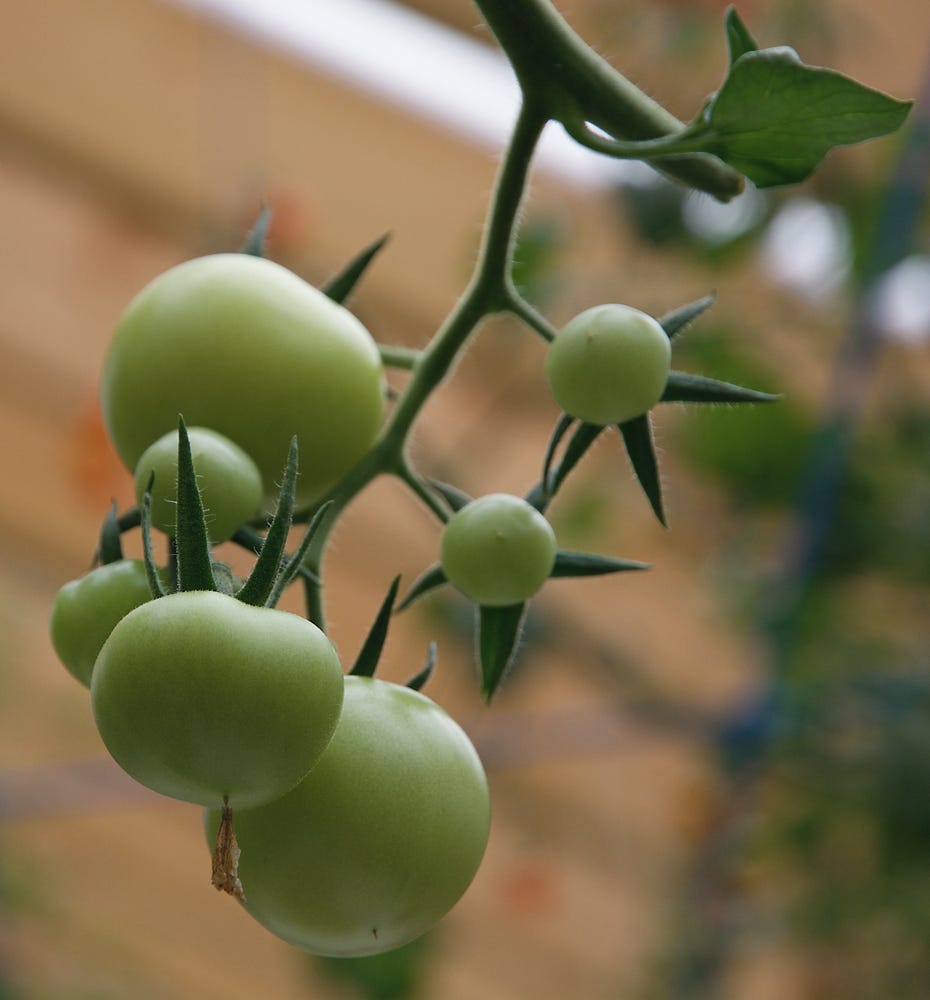

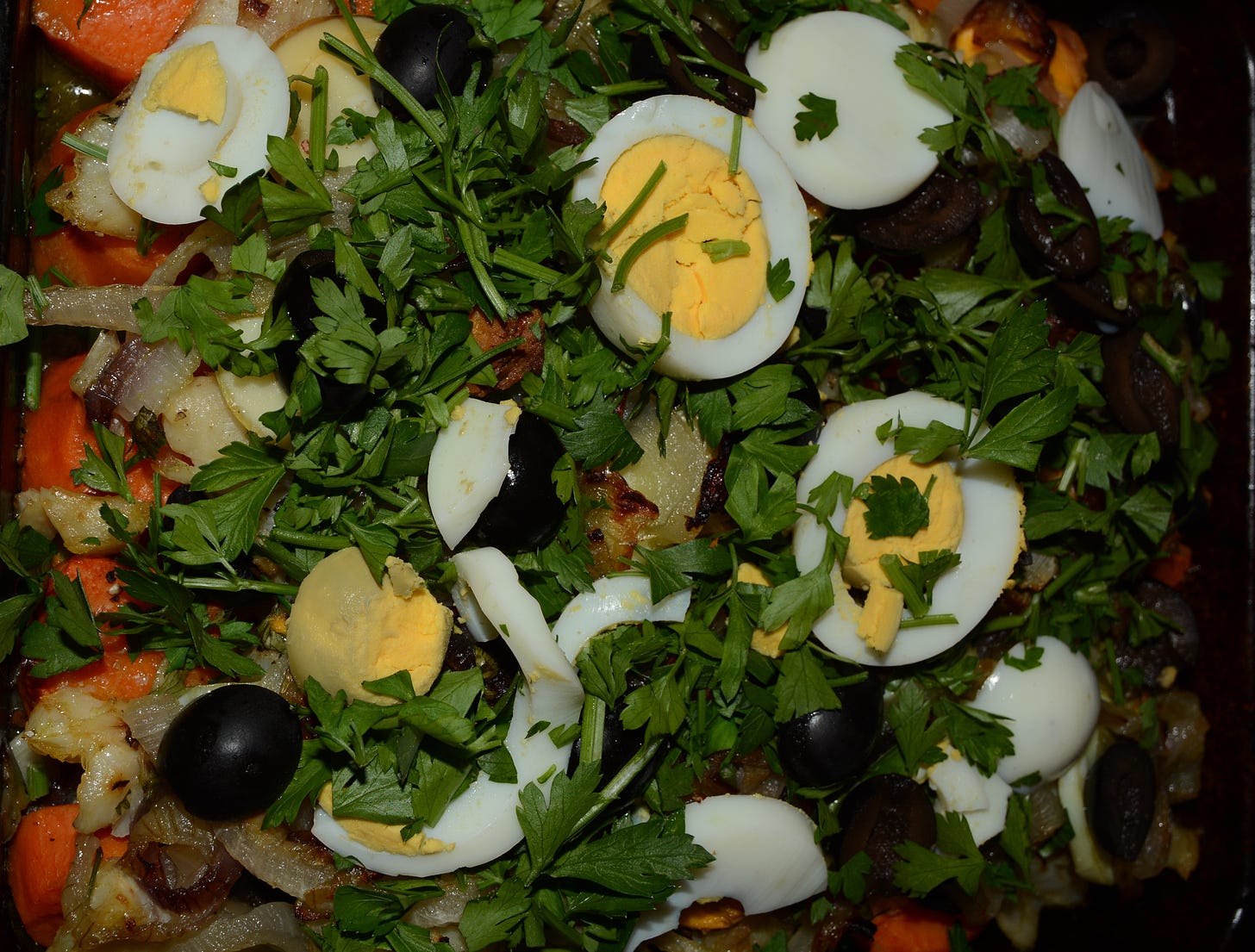



Loved reading this! You needn’t have had any doubts, brilliant piece of writing. You’ve just won yourself another subscriber. 😊
Great post and very inspirational. The Incredible Edible Todmorden still has a website https://www.incredible-edible-todmorden.co.uk/. After the initial great idea and the challenge of setting it up, you need a leader to keep it going.